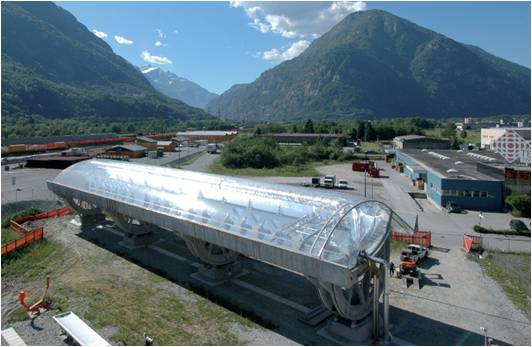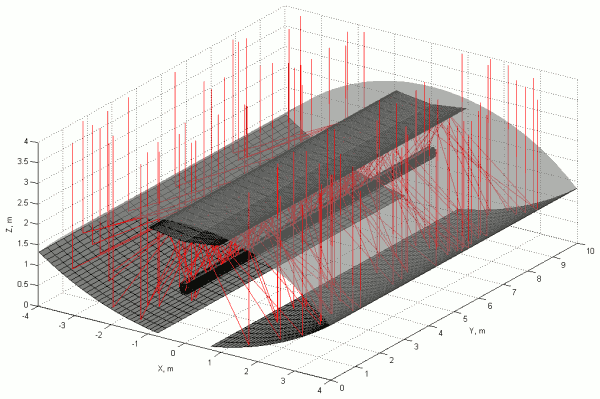AIRLIGHT – Solar Receiver Development for an Electricity Generation System
Partners: external page ALE Airlight Energy SA, external page SUPSI-iCIMSI
Funding source: external page BfE - Swiss Federal Office of Energy
Objective – Project aimed at the design, fabrication, testing, modeling & validation, and optimization of a solar receiver coupled with ALE’s trough concentrator, for a Rankine-based electricity generation system.

Fig. 1: ALE’s solar trough concentrator in Biasca, Switzerland

Fig. 2: Monte-Carlo ray tracing simulation of the ALE’s solar trough concentrator closed-coupled with a secondary reflector
The project encompasses the following phases:
- Experimental Characterization of Solar Concentrator – Measurements of the solar flux at the focal plane will be performed on-site and used to validate the Monte-Carlo (MC) simulation model.
- Receiver Design and Construction – A lab-scale solar receiver prototype will be designed and fabricated for an input solar power of 1 kW. The peripheral equipment such as the heat transfer fluid circuit system will be integrated to the receiver.
- Experimental Demonstration – The solar receiver will be tested at ETH’s High-Flux Solar Simulator and its performance will be evaluated according to the solar-to-heat thermal efficiency. A 2nd experimental campaign is to be performed with a 50m-length pilot receiver at Biasca.
- Receiver Modeling, Validation, and Optimization – The governing continuity, fluid flow, and energy equations will be formulated and solved by applying CFD and Monte-Carlo numerical techniques. Validation will be accomplished by comparing with experimental data obtained with the 1 kW prototype receiver at ETH and with the pilot (50-m length) receiver at Biasca. A parametric study will be carried out for optimizing the design and operation of a solar system for maximum thermal efficiency.
Project-related Publications
Publications information to follow soon.